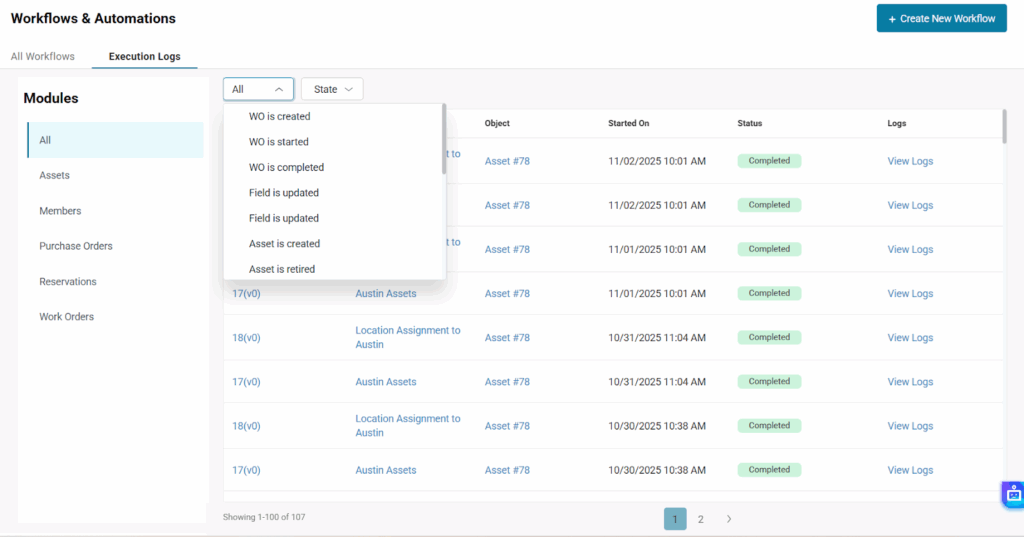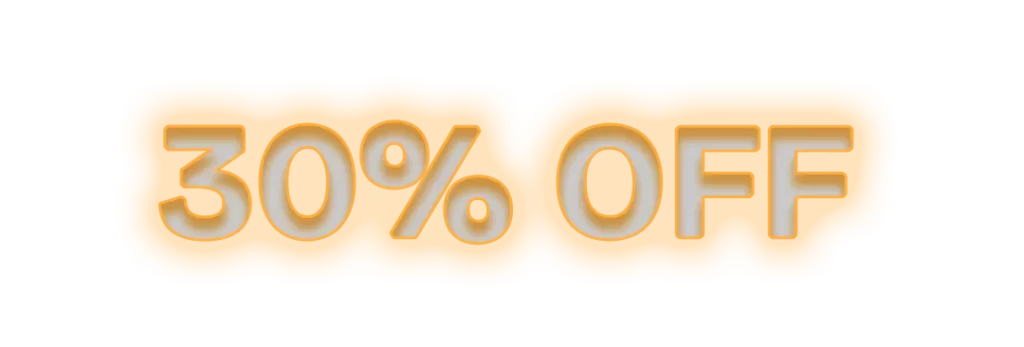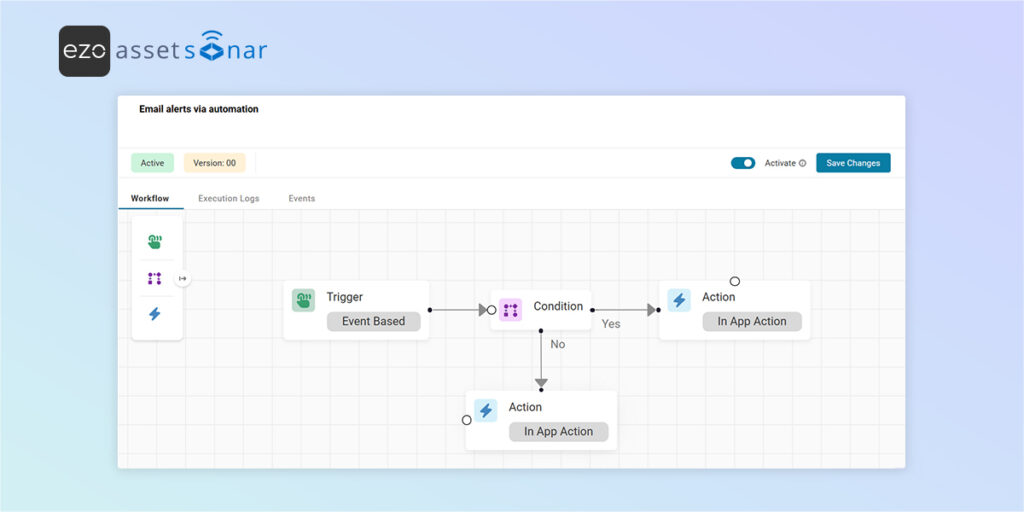AssetSonar’s automation capabilities offer a highly configurable way for organizations to automate IT asset management workflows across various operational processes. IT managers can create custom automations to streamline asset tracking, purchase order approvals, and work order management.
By allowing users to define triggers, conditions, and actions, automations reduce manual workload, enhance reliability, and minimize human error, ensuring that critical asset operations are executed automatically and consistently.
With EZO AssetSonar’s Workflow Automation Engine, you can now design powerful, visual workflows that automate these actions end-to-end.The new engine replaces the old trigger–sub-trigger model with a drag-and-drop, node-based canvas where you connect Triggers, Conditions, and Actions to create dynamic workflows.
Benefits of AssetSonar Automations
AssetSonar automations are ideal for organizations that rely heavily on IT asset management for optimized business processes and have a growing need for workflow automation to ensure scalability and efficiency. Here is how automated asset management workflows can add value to your business:
- Improved accuracy and reliability: Ensures critical workflows like device lifecycle tracking and compliance reporting are handled consistently, without human error.
- Customizability: Users can create highly specific automations to handle niche business needs, from custom triggers to multi-step workflows that span across different teams and systems.
- Scalability: As companies grow and scale their operations, the automation engine adapts, allowing more complex workflows and integration with additional software tools and systems.
- Cost Control: Reduces costs by automating the reclamation of unused software licenses, optimizing asset procurement cycles, and preventing overspending on IT resources.
- Increased efficiency: Update the asset attributes such as description, purchase on, cost, custom fields etc. based on different asset events and use conditions to narrow down to which assets you want to automate things, hence saving time and increasing efficiency.
Now let’s delve deeper to see how we can build these automations and put them to test:
Enabling Automation Module
To enable the automation, please go to Settings → Company Settings & Add-ons → Automations and select Enabled.

Click Update to save the settings.
Now go to Workflows & Automations (Navigation Menu) → Automations.

Explore the Automations Listing
The Automations Listing has been redesigned for better visibility and control.
- Tabs:
- All Workflows – lists every workflow in your account.
- Execution Logs – displays all past workflow runs.
These can be further filtered by the modules from the left panel (Assets, Purchase Orders, Work Orders, etc.)
- Search & Filters: Use the Filter icon beside the Search bar to open the filter pane.
- Status: Active / Inactive
- Triggers: Search or select from all triggers of the chosen module.
- Type: Different types of workflows based on how they are triggered. Currently, the automation engine has Event-based and Time-based triggers.
- Sequence Column: Determines the order of execution when multiple workflows share the same trigger.

Manage Workflows from the Listing
You can take quick actions on workflows directly from the Automations Listing without opening the editor:
- Activate/Deactivate: Toggle the status switch beside each workflow to instantly enable or disable it.

- Reorder Sequence: Edit the Sequence number inline to adjust execution priority for workflows sharing the same trigger. Lower Sequence number means relatively higher priority. So, for multiple workflows with same triggers the workflow with lower sequence will be executed first.
- Tip: When two workflows share the same trigger and sequence, they may execute in any order.

- Edit: Click the Edit icon at the end of a row to open that workflow in the visual editor.

Build a Workflow in the Visual Editor
Click Create New Workflow to open the canvas view.


Enter a Title (required) and optional Description. Then start building by clicking and dragging the following nodes onto the canvas.
Note: Only one Trigger can be added to a workflow, and a Trigger and an Action are mandatory for setting up a workflow.

Add a Trigger
A trigger defines when the workflow starts.
- Click the Trigger icon (shown below) and drag it onto the canvas.

- Next, click on the node you placed on the canvas.

- IIt will display a modal where you need to enter the Title and select the Trigger Type.
- The modal will update based on the Trigger Type you select.
- In case you select Event Based, you will be displayed the option to select the relevant Module and Trigger(s). Then click on Create Trigger.

Meanwhile, if you Time Based, you will need to select Module, Frequency, Time, and End Date. Time-based workflows execute at the scheduled time even if no qualifying items exist.

Note: You will not see any configuration options in the condition or action nodes until you select the module in the trigger. The options are configured based on the module selected in this node.

Let’s suppose you want to set up an automation where, if an asset is created, you receive an email for it. So you set up a trigger for when an asset is created, as shown above.
Add Conditions
Next, you may add a condition. This will check that certain conditions are met after the trigger, before any action is taken.
- Click the Condition icon (shown below) and drag it onto the canvas.

- Next, click on the condition node to configure it. You will see options relevant to the module selected.

- You may add one or more filters here.

Continuing our example, when an asset is created, the above condition will be true only when it is located in New York and it is an IT Asset.
- You may also create a more complex permutation of AND/OR logic to create more complex nesting structures and groups.

Finally, link the Trigger and Condition together by dragging the arrow from one node to the other.


Note: You may delink the two nodes by double-clicking the arrow.
- The canvas also automatically creates Yes and No branches, which may then be linked to the relevant actions, depending on what you want to automate when the conditions are either true or false.
Add Actions (Results of the Workflow)
These are the actions that you want the system to take when the automation is triggered, provided the conditions (if any) are met.
- Click the Action icon (shown below) and drag it onto the canvas.

- Next, click on the Action node to configure it. You will see options relevant to the module selected.

Based on our example above, if someone wants to automate receiving emails when the assets are created. They will perform the following steps:
- Click on Add Another Action.
- Select Send Email and then Update Form.

You will be displayed a form which you can fill out to update the recipients and the email that they will be sent.

Tip: The email can be sent to specific users, teams, or roles by changing the recipient type from the To dropdown.
- Once you fill it out, click Save to save the email format.
- You may add multiple actions following the same workflow and then click Add Action to add the action(s).
- Finally, link the Action node with the Trigger or the Condition node to complete the full automation flow.

Note: The automations module is extensive and has numerous permutations and variations. If you need assistance automating a specific workflow, you can reach out to us at support@ezo.io and we will help you set it up.
Trigger Webhooks
Another particularly interesting example of an action is Trigger Webhooks. It is an action that will inform another system when an automation event has happened in Assetsonar. The other systems can then call AssetSonar’s API to fetch the data or start any actions on their own system.

Click Configure to configure the Trigger Webhook. Enter the Callback URL and select whether you want to apply some form of authentication.

For authentication, you will get three options:
1. Click on No Authentication if you don’t have any authentication criteria.
2. Clicking on Basic Authentication will require you to provide a username and password as shown below:

3. The third option is to choose the API key. You’ll have to enter the API Key Name and API Key Value.

Once you have filled out all the designated fields, click on Save to create the new automation. It would start showing up on the automations detail page.
Automation Placeholders
While creating an automation, you can copy data from one field and map it to another. If you don’t want to set specific values for a field, you can insert a placeholder instead. You’ll just have to choose a placeholder field and the system will copy the value from that field.
So, for example, if you want the subject field to include the name of the asset created from the example above. You can add the relevant placeholder to both the Subject and Body of the emails sent. Refer to images below:

When you click on Insert Placeholder, you will be displayed the option to select a specific field to insert as displayed below:

Select the relevant placeholder and then click Insert Placeholder.

Please note that this is a dynamic field, and you’ll be able to view the placeholders relevant to the automation you are creating.
Execution Logs
From the Automations overview page, click on Execution Logs to view the number of times certain automation has executed.

You may filter the logs by selecting specific triggers or state. You may also filter these further by selecting the relevant module.


Additionally, you may click on the Title of any specific execution to view the details of the automation. Or click on View Logs to view the details of the automation execution.


Ready to Automate Your IT Workflows?
With the Workflow Automation, you can visually design and manage automations that streamline onboarding, ensure compliance, and eliminate manual effort.
Need help setting up your first workflow? Contact us at support@ezo.io — we’re happy to assist.




![[How to] Mass Deploy the AssetSonar Agent Using Microsoft Intune](https://cdn.ezo.io/wp-content/uploads/2021/09/20060637/As-blog-banner-19-Aug-scaled.jpg)
![[How-to] Enable Autocheckout in AssetSonar](https://cdn.ezo.io/wp-content/uploads/2023/07/25072627/How-to-Enable-Autocheckout-in-AssetSonar-scaled.jpg)
![[How-to] Allot License Keys in AssetSonar](https://cdn.ezo.io/wp-content/uploads/2025/06/18100358/How-to-Allot-License-Keys-in-AssetSonar-scaled.jpg)



